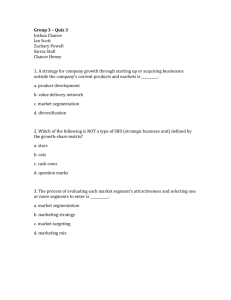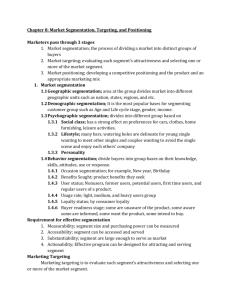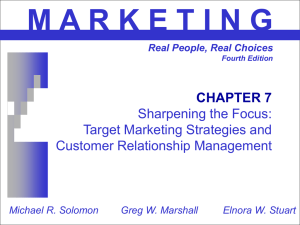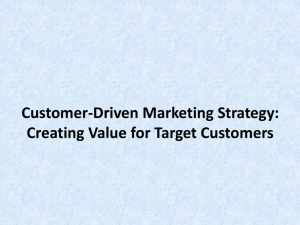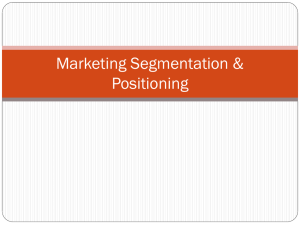Strategic Marketing Process
advertisement
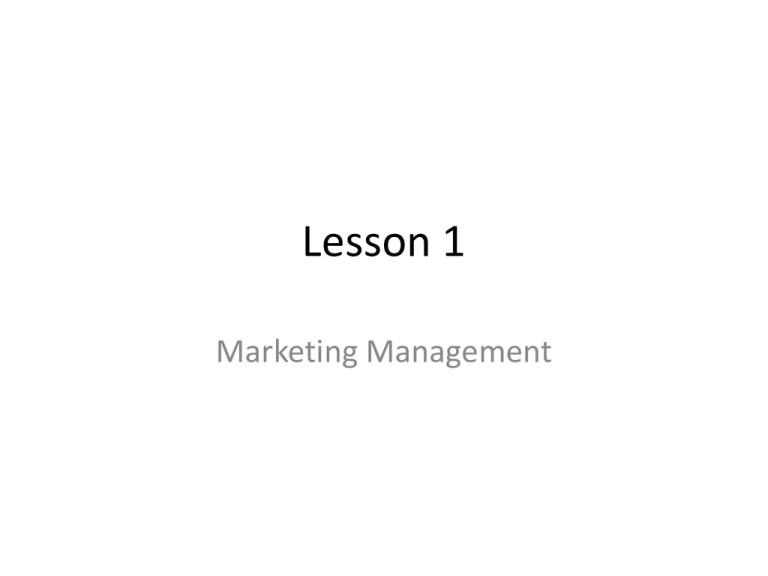
Lesson 1 Marketing Management Subject Detail • Unit 7: Strategic Marketing Management – Unit code: Y/602/2065 – QCF Level 7: BTEC Professional – Credit value: 10 – Guided learning hours: 30 Learning Outcome • Understand the principles of strategic marketing management Introduction to Marketing Miss Mary Lynn Mundell What Is Marketing? Simple definition: Marketing is the management process responsible for identifying, anticipating, and satisfying customer requirements profitably.” (CIM,2001) Goals: 1. Attract new customers by promising superior value. 2. Keep and grow current customers by delivering satisfaction. Marketing Defined • Marketing is the activity, set of instructions, and processes for creating, communicating, delivering, and exchanging offerings that have value for customers, clients, partners, and society at large. OLD view of marketing: NEW view of marketing: Making a sale— “telling and selling” Satisfying customer needs Why is Marketing Important? Shifting Business Paradigms Buyers’ markets Sellers’ markets The Marketing Process A simple model of the marketing process: • Understand the marketplace and customer needs and wants. • Design a customer-driven marketing strategy. • Construct an integrated marketing program that delivers superior value. • Build profitable relationships and create customer delight. • Capture value from customers to create profits and customer quality. Needs, Wants, and Demands Need: State of felt deprivation including physical, social, and individual needs. • Physical needs: Food, clothing, shelter, safety • Social needs: Belonging, affection • Individual needs: Learning, knowledge, self-expression Want: Form that a human need takes, as shaped by culture and individual personality. • Wants + Buying Power = Demand Need/ Want Fulfillment Needs & wants are fulfilled through a Marketing Offering: • Products: – Persons, places, organizations, information, ideas. • Services: – Activity or benefit offered for sale that is essentially intangible and does not result in ownership. • Experiences: – Consumers live the offering. Customer Value and Satisfaction Dependent on the product’s perceived performance relative to a buyer’s expectations. Care must be taken when setting expectations: • If performance is lower than expectations, satisfaction is low. • If performance is higher than expectations, satisfaction is high. Customer satisfaction often leads to consumer loyalty. Some firms seek to DELIGHT customers by exceeding expectations. Marketing Management The art and science of choosing target markets and building profitable relationships with them. • Requires that consumers and the marketplace be fully understood. • Aim is to find, attract, keep, and grow customers by creating, delivering, and communicating superior value. Marketing Management Marketing managers must consider the following, to ensure a successful marketing strategy: 1. What customers will we serve? — What is our target market? 2. How can we best serve these customers? — What is our value proposition? Choosing a Value Proposition The set of benefits or values a company promises to deliver to consumers to satisfy their needs. • Value propositions dictate how firms will differentiate and position their brands in the marketplace. The Marketing Concept The marketing concept: • A marketing management philosophy that holds that achieving organizational goals depends on knowing the needs and wants of target markets and delivering the desired satisfaction better than competitors. Customer Perceived Value Customer perceived value: – “Customer’s evaluation of the difference between all of the benefits and all of the costs of a marketing offer relative to those of competing offers.” (Armstrong & Kotler) – Perceptions may be subjective – Consumers often do not objectively judge values and costs. Customer value = perceived benefits – perceived sacrifice. The Marketing Mix The set of controllable, tactical marketing tools that the firm blends to produce the response it wants in the target market. • Product: Variety, features, brand name, quality, design, packaging, and services. • Price: List price, discounts, allowances, payment period, and credit terms. • Place: Distribution channels, coverage, logistics, locations, transportation, assortments, and inventory. • Promotion: Advertising, sales promotion, public relations, and personal selling. Marketing Strategy Customer-Driven Marketing Strategy Requires careful customer analysis. To be successful, firms must engage in: • Market segmentation • Market targeting • Differentiation • Positioning Market Segmentation and Targeting Segmentation: • The process of dividing a market into distinct groups of buyers with different needs, characteristics, or behavior who might require separate products of marketing programs. Targeting: • Involves evaluating each market segment’s attractiveness and selecting one or more segments to enter. Differentiation and Positioning Differentiation: • Creating superior customer value by actually differentiating the market offering. Positioning: • Arranging for a product to occupy a clear, distinctive, and desirable place relative to competing products in the minds of target consumers. Market Segmentation Key segmenting variables: • Geographic • Demographic • Psychographic • Behavioral Different segments desire different benefits from products. Best to use multivariable segmentation bases in order to identify smaller, better-defined target groups. Market Segmentation Why Segment?: • Meet consumer needs more precisely • Increase profits • Segment leadership • Retain customers • Focus marketing communications Evaluating Market Segments Segment size and growth: • Analyze current segment sales, growth rates, and expected profitability. Segment structural attractiveness: • Consider competition, existence of substitute products, and the power of buyers and suppliers. Company objectives and resources: • Examine company skills and resources needed to succeed in that segment. • Offer superior value and gain advantages over competitors. Market Targeting Market targeting involves: • Evaluating marketing segments. – Segment size, segment structural attractiveness, and company objectives and resources are considered. • Selecting target market segments. – Alternatives range from undifferentiated marketing to micromarketing. • Being socially responsible. Differentiation and Positioning A product’s position is: • The way the product is defined by consumers on important attributes—the place the product occupies in consumers’ minds relative to competing products. • Perceptual positioning maps can help define a brand’s position relative to competitors. Differentiation and Positioning Identifying possible value differences and competitive advantages: • Key to winning target customers is to understand their needs better than competitors do and to deliver more value. Competitive advantage: • Extent to which a company can position itself as providing superior value. – Achieved via differentiation. What's next? Weekly Program • 1.1 discuss the role of strategic marketing in an organisation • 1.2 explain the processes involved in strategic marketing • 1.3 evaluate the links between strategic marketing and corporate Strategy Today’s Objective • 1.1 Discuss the role of strategic marketing in an organisation Main issues to discuss LO 1 • Role of strategic marketing: key definitions of strategic marketing from the Chartered Institute of Marketing and key authors (eg Hugh Davidson; Peter Doyle; Philip Kotler; Malcolm McDonald); • role and importance of strategic marketing in an organisation; concepts; systematic approach; sequencing and scheduling of activities; integration of activities; resource requirements; timescaling; onitoring and control elements • Processes: strategic marketing planning processes (eg Peter Doyle, Malcolm McDonald) including strategic marketing analysis, marketing strategy objective setting, perceptual mapping, factor analysis, option evaluation, choice, • formulation, implementation and control Links to corporate strategy: the nature of strategy and marketing links to corporate strategy eg Michael Porter; links to mission statement, organisational structure, corporate responsibility and ethics; dynamic strategy (Carpenter and Sanders); knowledge management systems Focus on Strategic Marketing Marketing - Definition • The management process responsible for identifying, anticipating and satisfying customer requirements profitably Strategic Marketing • Strategic marketing focuses on how to develop competitive advantage through the drivers of shareholder value. Delivering value to your business requires insight into your changing marketplace and decisions regarding how to match your organisation’s distinctive capabilities with promising value opportunities. Being able to do this is the key for many marketers to increase their influence in the organisation FIGURE 2-1 The three levels of strategy in organizations: corporate, business unit, and functional ORGANIZATIONS AND THEIR LEVELS OF STRATEGY • Strategy Issues in Organizations Goals or Objectives • Profit • Customer Satisfaction • Sales • Employee Welfare • Market Share • Social Responsibility • Quality THE STRATEGIC MARKETING PROCESS • How do we allocate our resources to get where we want to go? • How do we convert our plans to actions? • How do our results compare with our plans, and do deviations require new plans? Strategic Marketing Process Marketing Plan FIGURE 2-4 The strategic marketing process THE STRATEGIC MARKETING PROCESS • Strategic Marketing Process: The Planning Phase Step 1: Situation (SWOT) Analysis • Situation Analysis • SWOT Analysis Strengths Weaknesses Opportunities Threats FIGURE 2-5 Ben & Jerry’s: a SWOT analysis to get it growing again Ben & Jerry’s One Sweet Whirled Campaign What is the impact of a SWOT analysis? THE STRATEGIC MARKETING PROCESS • Strategic Marketing Process: The Planning Phase Step 2: Market-Product Focus and Goal Setting • Market Segmentation • Set Marketing and Product Goals • Select Target Markets • Find Points of Difference • Position the Product THE STRATEGIC MARKETING PROCESS • Strategic Marketing Process: The Planning Phase Step 3: Marketing Program • Product Strategy • Price Strategy • Promotion Strategy • Place (Distribution) Strategy FIGURE 2-6 Elements of the marketing mix that comprise a cohesive marketing program THE STRATEGIC MARKETING PROCESS • Strategic Marketing Process: The Implementation Phase Obtaining Resources Designing the Marketing Organization Developing Schedules FIGURE 2-7 Organization of a typical manufacturing firm showing a breakdown of the marketing department THE STRATEGIC MARKETING PROCESS • Strategic Marketing Process: The Implementation Phase Executing the Marketing Program • Marketing Strategy • Marketing Tactics THE STRATEGIC MARKETING PROCESS • Strategic Marketing Process: The Control Phase Comparing Results With Plans to Identify Deviations • Planning Gap Acting on Deviations • Exploiting a Positive Deviation • Correcting a Negative Deviation SUPPLEMENTAL LECTURE MARKETING VERSUS BUSINESS PLANS FIGURE A-1 Elements in typical marketing and business plans targeted at different audiences FIGURE 2-A Results of good and bad marketing planning and implementation FIGURE 2-E Gantt chart for scheduling the term project Profit Profit is the reward to a business firm for the risk it undertakes in offering a product for sale. It is also the money left over after a firm’s total expenses are subtracted from its total sales. Mission Mission is a statement of the organization’s scope, often identifying its customers, markets, products, technology, and values. Organizational Culture Organizational culture is a set of values, ideas, and attitudes that is learned and shared among the members of an organization. Goals or Objectives Goals or objectives convert the mission into targeted levels of performance to be achieved, often by a specific time. Market Share Market share is the ratio of sales revenue of the firm to the total sales revenue of all firms in the industry, including the firm itself. Strategic Marketing Process The strategic marketing process is the approach whereby an organization allocates its marketing mix resources to reach its target markets. Marketing Plan A marketing plan is a road map for the marketing activities of an organization for a specified future period of time, such as one year or five years. Situation Analysis Situation analysis involves taking stock of where a firm or product has been recently, where it is now, and where it is headed in terms of the organization’s plans and the external factors and trends affecting it. SWOT Analysis SWOT analysis is an acronym describing an organization’s appraisal of its internal Strengths and Weaknesses and its external Opportunities and Threats. Market Segmentation Market segmentation involves aggregating prospective buyers into groups, or segments, that (1) have common needs and (2) will respond similarly to a marketing action. Points of Difference Points of difference are those characteristics of a product that make it superior to competitive substitutes. Marketing Strategy A marketing strategy is the means by which a marketing goal is to be achieved, usually characterized by a specific target market and a marketing program to reach it. Marketing Tactics Marketing tactics are detailed day-to-day operational decisions essential to the overall success of marketing strategies.
